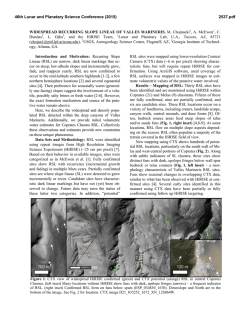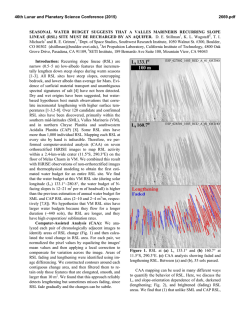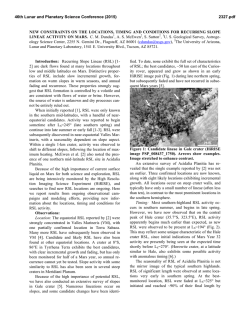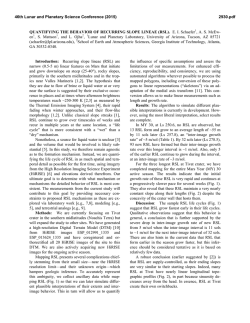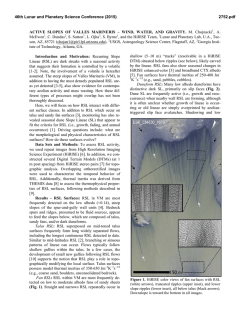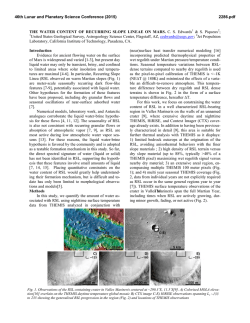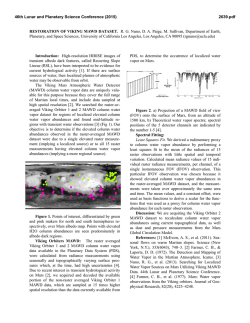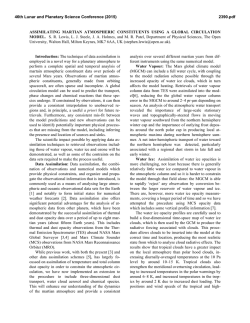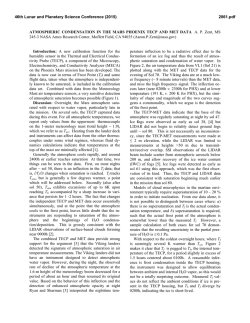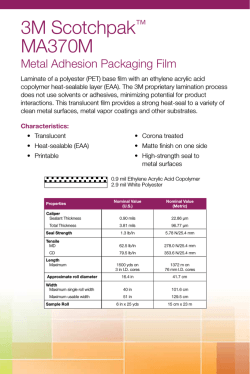
Mesoscale Atmospheric Modeling of Water Vapor in Valles Marineris
46th Lunar and Planetary Science Conference (2015) 2959.pdf MESOSCALE ATMOSPHERIC MODELING OF WATER VAPOR IN VALLES MARINERIS. C. W. S. Leung1, S. C. R. Rafkin2, and A. S. McEwen1, 1Lunar and Planetary Laboratory, University of Arizona, Tucson, AZ 85712 ([email protected]), 2Southwest Research Institute, 1050 Walnut St., Suite 300, Boulder, CO 80302. Introduction: In the present climate on Mars liquid water is unstable at the surface, yet flow-like features such as Recurring slope lineae (RSL) may indicate the presence of liquid water on or very near the surface [1]. In addition to the sites in the southern midlatitudes, extensive RSL activity has been detected in the tropics in Valles Marineris [2]. The apparent temperature dependence of RSL, especially the incremental growth during warm seasons and rapid fading in cold seasons, suggests intermittent flow of briny water [2]. The origin of RSL remains an open question, but hypotheses for the source of volatile include seeping water, melting shallow ice, and water from the atmosphere [2]. Morning ice fogs, such as those observed in the Noctis Labyrinthus region of Valles Marineris, may be significant to the formation of RSL [2]. To understand the near-surface water cycle in Valles Marineris, drawing insight into the origin of RSL, we investigate near-surface winds, the water vapor abundance in the boundary layer, as well as how the water vapor varies with time of day. We use mesoscale simulations to investigate to what degree the local near surface water budget affects the dynamics and concentration of near surface water and atmospheric vapor at key RSL sites. Mesoscale Model: For our simulations, we use the Mars Regional Atmospheric Modeling System (MRAMS), which is a 3-D mesoscale model dedicated to studying the fully integrated atmospheric dynamics at the regional-scale [3]. The complicated topographic differentials in and around Valles Marineris greatly affect the regional atmospheric circulation, resulting in a dynamic region of mesoscale meteorological interactions. MRAMS is especially appropriate for this study because of its ability to produce data at high temporal and spatial resolution over short periods of time. It represent one of the best ways to provide regional context to understand the physical processes indicated by observations obtained from the High Resolution Imaging Science Experiment (HiRISE). Modeling Approach: Our modeling efforts investigate the seasonal and diurnal variation in water vapor abundances in a variety of regions across Valles Marineras. Extensive RSL activity has been detected in Capri Chasma, where the largest RSL up to 1.2 km long are observed [2]. Other areas with large concentrations of RSL include regions in Coprates Chasma, particularly in the West Coprates Ridge and East Coprates Massif [2]. Whereas RSL largely concentrate at the eastern end of Valles Marineris, morning ice fogs appear closer to the western end of the canyon. The Viking Orbiter has imaged striking examples of nearsurface fogs lingering shortly after dawn in the canyons of the Noctis Labyrinthus region at the western end of Valles Marineris [4]. Provided the atmospheric vapor concentration is high enough, water ice fogs form overnight as the surface temperature cools below the condensation point for water, and dissipate by midmorning as the atmosphere is heated and the daytime convective boundary layer develops [5]. Our simulations have wide spatial coverage encompassing regions in Valles Marineris with high abundance of RSL, areas with no RSL activity, as well as regions of fog formation. Results: Simulated variations in winds, temperature, pressure, and column vapor abundances offer a spatial and temporal analysis of the near surface atmospheric water budget, as well as trends in volatile transport pathways. We account for slope effects on the local circulation and investigate the extent which regional topography drives the wind fields & regulate regional atmospheric vapor abundances. Preliminary model results show that the temperature inside the canyon in Valles Marineris is found to be warmer than the surrounding plateaus. This is particularly interesting because observed morning ice fog is present inside the canyon, but absent outside. Since the formation of fogs typically require the surface to drop below the condensation temperature, it is curious that fog would be present within the warm canyon yet not on the colder surrounding plateau. One possible explanation is a local water source. Peak vapor column abundances of ~10-15um during Ls = 210-240° poorly matches the peak season for RSL activity within Valles Marineris [2]. However, atmospheric water vapor may still play a significant role by diffusing into the soil and become adsorbed onto soil particles. Subsequent vapor release from the regolith can have significant effects on the local relative humidity. Water ice fogs and local circulation of vapor within Valles Marineris could facilitate deliquescence or recharge of water ice in the shallow subsurface and serve as a source of volatile for RSL. References: [1] McEwen A. S. et al. (2011) Science, 333, 740-743. [2] McEwen A. S. et al. (2014) Nature Geoscience, 7, 53-58. [3] Rafkin S. C. R. et al. (2001) Icarus, 151, 228-256. [4] Möhlmann, D.T. et al. (2009) Planetary and Space Science, 57(14), 1987-1992. [5] Read, P. L. and Lewis, S. R. (2004) Springer.
© Copyright 2025
